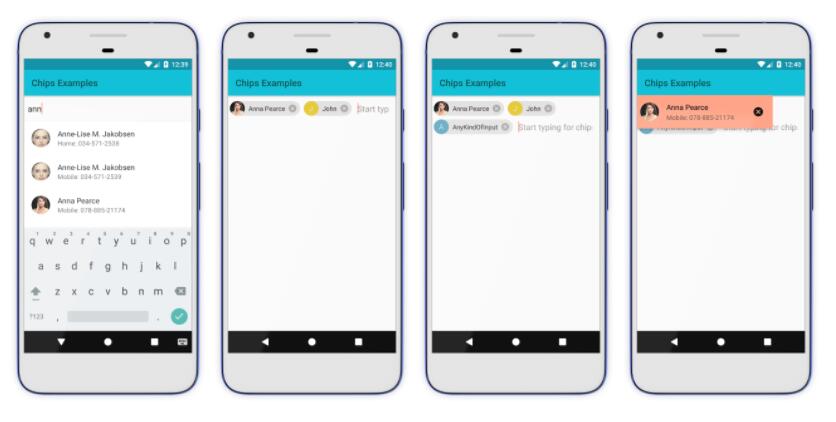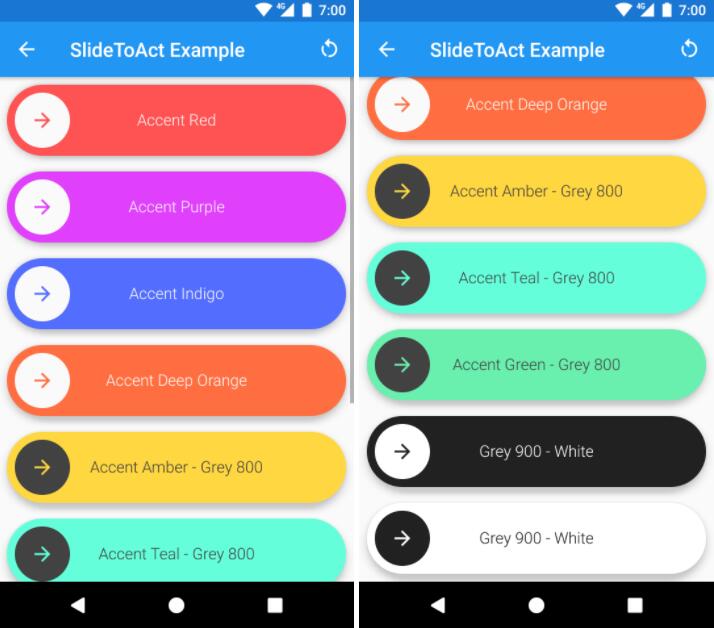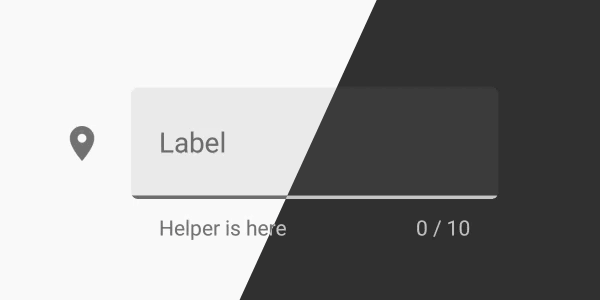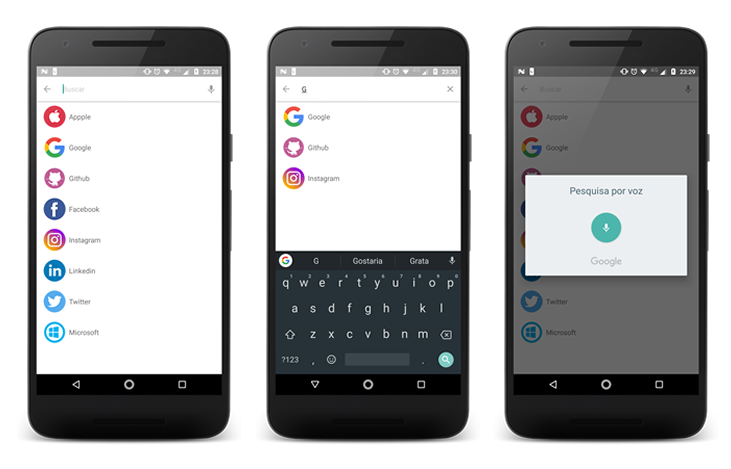Chips Input Layout
A highly customizable Android ViewGroup for displaying Chips (specified in the Material Design Guide).
How to use it...
In your project level build.gradle :
In your app level build.gradle:
Core features of this library:
- Use libraries (Glide, Picasso,...) to load chip avatars
- Filter chips as user inputs text
- Allow user to create custom chips
- Specify if chips show details, are deletable, or have an avatar
- Specify how chips are managed/stored in-memory
- Validate any chips
- Highly customizable chips
- Strictly sticks to the Google Material Design Guide
Honorable Mentions:
- This uses a RecyclerView layout manager: https://github.com/BelooS/ChipsLayoutManager
Using the ChipsInputLayout
The purpose of this library is to allow users to interact with chips, specified in the Google Material Design Guide. To achieve this functionality, you'll need to use the ChipsInputLayout view.
Using in an XML layout
ChipsInputLayout can be used in any ViewGroup and supports all width and height attributes. Simple usage is shown here:
Here is a table of all the XML attributes available for this view:
| Attribute | Type | Summary |
|---|---|---|
android:hint |
string |
Hint shown in the chips input. |
android:textColorHint |
color |
Text color of the hint shown in the chips input. |
android:textColor |
color |
Text color of chips input. |
app:allowCustomChips |
boolean |
True if user is allowed to enter custom chips. |
app:hideKeyboardOnChipClick |
boolean |
True if the keyboard should hide when a filterable chip is clicked. |
app:maxRows |
int |
Maximum number of rows used to display chips. |
app:chip_showDetails |
boolean |
True if clicking a chip should show its details. |
app:chip_showAvatar |
boolean |
True if each chip should show an avatar icon. |
app:chip_showDelete |
boolean |
True if each chip should be deletable by the user. |
app:chip_deleteIcon |
reference |
Changes the chips' delete icons. |
app:chip_deleteIconColor |
color |
Color of each chips' delete icon. |
app:chip_backgroundColor |
color |
Color of each chips' background. |
app:chip_textColor |
color |
Text color of each chips' title and subtitle. |
app:details_deleteIconColor |
color |
Color of each detailed chips' delete icon. |
app:details_backgroundColor |
color |
Color of each detailed chips' background. |
app:details_textColor |
color |
Text color of each detailed chips' title and subtitle. |
app:filter_elevation |
dimension |
Elevation of the filterable list. |
app:filter_backgroundColor |
color |
Color of the filterable list's background. |
app:filter_textColor |
color |
Text color of the filterable list's items. |
Using in Java code
ChipsInputLayout can be programmatically added into any ViewGroup. Simple usage in an Activity is shown here:
Here is a table of all the accessible attributes available for this view:
| Method | Summary |
|---|---|
setInputHint(CharSequence) |
Changes hint shown in the chips input. |
setInputHintTextColor(ColorStateList) |
Changes text color of the hint shown in the chips input. |
setInputTextColor(ColorStateList) |
Changes text color of chips input. |
setShowDetailedChipsEnabled(boolean) |
True if clicking a chip should show its details. |
setCustomChipsEnabled(boolean) |
True if user is allowed to enter custom chips. |
setHideKeyboardOnChipClick(boolean) |
True if the keyboard should hide when filterable chip is clicked. |
setMaxRows(int) |
Changes maximum number of rows used to display chips. |
setTypeface(Typeface) |
Changes the typeface of the ChipsInputLayout and all associated textual-based components. |
setChipTitleTextColor(ColorStateList) |
Changes text color of each chips' title and subtitle. |
setShowChipAvatarEnabled(boolean) |
True if each chip should show an avatar icon. |
setChipsDeletable(boolean) |
True if each chip should be deletable by the user. |
setChipDeleteIconColor(ColorStateList) |
Changes color of each chips' delete icon. |
setChipBackgroundColor(ColorStateList) |
Changes color of each chips' background. |
setChipDeleteIcon(Drawable) |
Changes the each chips' delete icon. |
setChipDeleteIcon(int) |
Overload of setChipDeleteIcon(Drawable). |
setChipDetailsTextColor(ColorStateList) |
Changes text color of each detailed chips' title and subtitle. |
setChipDetailsBackgroundColor(ColorStateList) |
Changes color of each detailed chips' background. |
setChipDetailsDeleteIconColor(ColorStateList) |
Changes color of each detailed chips' delete icon. |
setFilterListBackgroundColor(ColorStateList) |
Changes color of the filterable list's background. |
setFilterListTextColor(ColorStateList) |
Changes text color of the filterable list's items. |
setFilterListElevation(float) |
Changes elevation of the filterable list. |
setInputType(int) |
Sets the text input type on the ChipsEditText. |
setOnChipsInputTextChangedListener(OnChipsInputTextChangedListener) |
Sets a text changed listener that gets invoked when text it changed on the ChipsEditText. |
Using the Chips
There are a plethora of ways you can manipulate chips in ChipsInputLayout. However, the main abilities afforded by ChipsInputLayout are that you can set a list of chips that can be filtered by user input and set a list of chips that are pre-selected. Other features are listed in the table below.
Creating a chip
Chip is the base object needed for ChipsInputLayout, and associated components in the library, to work properly. ChipsInputLayout can work with anything that is a Chip. So, that means that you can create any type of 'chip' data you want... simply inherit the Chip class and you're good to go!
Here's a small example:
Setting a filterable list of chips in ChipsInputLayout
ChipsInputLayout supports the ability to show/hide a list of chips that are filterable as the user inputs text into it. To use this feature, simply call setFilterableChipList(List) in ChipsInputLayout.
Not calling setFilterableChipList(List) will imply you don't wish to use that feature, therefore, ChipsInputLayout, will not show/hide the filterable list as the user inputs text.
Here is a simple example:
Setting a pre-selected list of chips in ChipsInputLayout
ChipsInputLayout supports the ability to set an already-selected list of chips. To use this feature, simply call setSelectedChipList(List) in ChipsInputLayout.
Here is a simple example:
Other chip manipulation methods in ChipsInputLayout
| Method | Summary |
|---|---|
addFilteredChip(Chip) |
Adds a new chip to the filterable chips, which will update the UI accordingly because of the change observers. |
addSelectedChip(Chip) |
Adds a new chip to the selected chips, which will update the UI accordingly because of the change observers. |
clearFilteredChips() |
Clears all the filterable chips, which will update the UI accordingly because of the change observers. |
clearSelectedChips() |
Clears all the selected chips, which will update the UI accordingly because of the change observers. |
getSelectedChips() |
Gets all the currently selected chips. |
getFilteredChips() |
Gets all the currently filtered chips. |
getOriginalFilterableChips() |
Gets all the originally set filterable chips. |
getSelectedChipByPosition(int) |
Gets a selected chip using the given index. |
getSelectedChipById(Object id) |
Gets a selected chip using the given ID, if possible. |
getSelectedChipByTitle(String, boolean) |
Gets a selected chip with exactly the given title or like the given title. |
getSelectedChipBySubtitle(String, boolean) |
Gets a selected chip with exactly the given subtitle or like the given subtitle. |
getFilteredChipPosition(int) |
Gets a filtered chip using the given index. |
getFilteredChipById(Object) |
Gets a filtered chip using the given ID, if possible. |
getFilteredChipByTitle(String, boolean) |
Gets a filtered chip with exactly the given title or like the given title. |
getFilteredChipBySubtitle(String, boolean) |
Gets a filtered chip with exactly the given subtitle or like the given subtitle. |
doesChipExist(Chip) |
Checks if the given chip exists in either the filterable or selected chips. |
isChipFiltered(Chip) |
Checks if the given chip exists in the filtered chips. |
isChipSelected(Chip) |
Checks if the given chip exists in the selected chips. |
getChipDataSource() |
Gets the currently used chip data source. |
changeChipDataSource(ChipDataSource) |
Changes the chip data source being used to manage chips, cloning existing observers. |
Managing the Chips
Where this library capitalizes, is how it decentralizes where and how the selected and filterable chips are stored. This makes accessing and receiving updates to data source changes from various Android components really simple.
All chips are managed by, ChipDataSource, which is an abstraction to decouple the concrete implementation of how the abstract methods manage the chips. This means that other implementations of ChipDataSource can be made at your own leisure. Simply call changeChipDataSource(ChipDataSource) in ChipsInputLayout to use your implementation of ChipDataSource.
Although not required, but definitely recommeneded, you can inherit the semi-concrete, ObservableChipDataSource, which is an implementation of ChipDataSource that handles the observer functionality for you properly so that it simplifies writing other ChipDataSource implementations.
By default, ChipsInputLayout will automatically use ListChipDataSource; which is out-of-the-box really good at being processing and memory efficient, and it relies on the ArrayList to manage chips.
Observing chip selection changes
ChipDataSource has the ability to notify observers that want to observe specific chip selection events in ChipDataSource. The observers will be notified if a chip has been selected or unselected from the selected chip list in ChipDataSource. Both selection and deselection events will afford the chip that was selected or deselected respectively.
To use this functionality, you'll want to implement the ChipDataSource.SelectionObserver and register it on ChipDataSource. Be sure to manage unregistering the observer, if need be, as well.
To set the observer, you'll need to call the addSelectionObserver(ChipDataSource.SelectionObserver) method in ChipsInputLayout.
Here is a simple example:
Observing any change to the chip data source
ChipDataSource has the ability to notify observers that want to observe any type of change to the data in ChipDataSource. The observers will be notified if a chip has been added or removed from either the selected or filtered lists in the ChipDataSource; however, there's no information about the event though.
This is used internally by the library to trigger UI updates on RecyclerView adapters when the data has changed.
To use this functionality, you'll want to implement the ChipDataSource.ChangeObserver and register it on ChipDataSource. Be sure to manage unregistering the observer, if need be, as well.
To set the observer, you'll need to call the addChangeObserver(ChipDataSource.ChangeObserver) method in ChipsInputLayout.
Here is a simple example:
Using Image Loading Libraries (Glide, Picasso,...)
This library affords the ability to use custom image rendering so that you can use any 3rd-party image loading libraries that you wish. ChipImageRenderer is provided to the library components to use when they need to load chip avatars.
By default, ChipsInputLayout will use its own implementation of ChipImageRenderer, but you can provide a custom implementation to use instead by calling setImageRenderer(ChipImageRenderer) in ChipsInputLayout.
Here's a small example (using Glide):
Chip Validation
This library also affords the ability to validate chips. Chip validtion can be used for a plethora of reasons or use-cases. Validation can be done on the selected chips or on a single chip itself.
Validation is abstracted by the ChipValidator interface. This allows you to provide your own implementation of chip validation for whatever purpose you want or need it for. By default, there is no implementation of ChipValidator set or provided by this library.
Creating a chip validator
ChipValidator must be implemented in order to write your own chip validation logic. ChipValidator has one method only, validate(Chip), and it is used to determine when a single given chip should be considered valid.
Here's a small example:
Setting a chip validator
A custom implementation of ChipValidator can be set using the ChipsInputLayout. Simply call the setChipValidator(ChipValidator) method in ChipsInputLayout.
Here's a simple example:
Using a chip validator
Using a chip validator is really easy! After setting a chip validator in ChipsInputLayout, you can validate a single given chip or all the selected chips.
Validating a single given chip can be done by calling, validateChip(Chip), in ChipsInputLayout. Validating all the selected chips can be done by calling, validateSelectedChips(), in ChipsInputLayout. When you call either of those methods without having set a chip validator, it will simply return true.
Here's a simple example:





